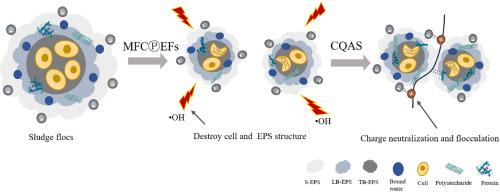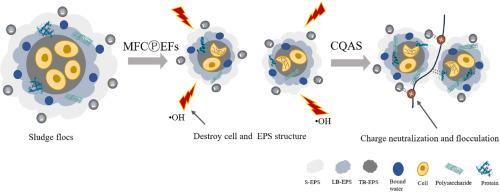以微生物燃料电池为动力的电-芬顿系统(MFCⓅEFs)与壳聚糖季铵盐耦合可改善污泥脱水性能
IF 10
1区 环境科学与生态学
Q1 ENGINEERING, ENVIRONMENTAL
引用次数: 0
摘要
随着废水处理设施的改进和扩大,污泥脱水是一项基本工序,但由于污泥中含有大量复杂的有机物,污泥脱水也是一项重大挑战。微生物燃料电池驱动的电-芬顿系统(MFCⓅEFs)作为一种高效、低能耗的改良方法,已被证明可产生-OH 并破坏亲水性胞外聚合物物质(EPS)。然而,处理后的污泥粒径较小,部分有机物会释放到上清液中,这可能会影响污泥-水分离过程。壳聚糖季铵盐(CQAS)作为一种可再生、可生物降解的阳离子混凝剂,可参与后续处理。联合处理后的污泥具有更好的脱水性能,污泥饼含水率(WCSC)、毛细管抽吸时间(CST)和比阻过滤(SRF)分别为 61.21%、15.6 s 和 1.02×1012 m/kg(减少 26.47%、80.72% 和 84.28%)。MFCⓅEFs的氧化作用破坏了细胞结构和EPS结构,CQAS的架桥絮凝和电荷中和作用使细小颗粒相互挤压。联合处理充分降低了表面负电荷和亲水性物质的含量,影响了 N-H 键强度的变化,改变了蛋白质二级结构,使其变得更松散,从而释放出更多的结合水,同时改善了聚集特性。总之,联合处理可显著提高污泥脱水性,并具有高效、低能耗、安全、无毒等运行优势。本文章由计算机程序翻译,如有差异,请以英文原文为准。


Sludge dewaterability improvement in microbial fuel cell powered electro-Fenton system (MFCⓅEFs) coupled with chitosan quaternary ammonium salt
As improved and expanded wastewater treatment facilities, sludge dewatering is the essential process and major challenge due to the complex and abundant organic matter. Microbial fuel cell powered electro-Fenton system (MFCⓅEFs) has been demonstrated to generate •OH and destroy hydrophilic extracellular polymeric substances (EPS) as an improved method of high efficiency and low energy consumption. Nevertheless, the smaller particle size of the treated sludge and the release of partial organic matter into the supernatant can affect the sludge-water separation process. Chitosan quaternary ammonium salt (CQAS) as a renewable and biodegradability cationic coagulant can be involved in the follow-up treatment. The sludge after combined treatment exhibited better dewaterability, where the water content of sludge cake (WCSC), capillary suction time (CST), and specific resistance filtration (SRF) were 61.21%, 15.6 s, and 1.02 × 1012 m/kg (26.47%, 80.72% and 84.28% reduction), respectively. The oxidation of the MFCⓅEFs destroyed the cellular and EPS structure and the bridging flocculation and charge neutralization of CQAS caused the fine particles to squeeze each other. The combined treatment fully reduced the content of negative charge and hydrophilic substances on the surface, which affected the intensity change of N-H bond and altered the protein secondary structure to make it looser, thus releasing more bound water while improving aggregation characteristics. Overall, combined treatment can significantly improve sludge dewaterability and owns operational advantages of high efficiency, low energy and chemical consumption, safety, and non-toxicity.
求助全文
通过发布文献求助,成功后即可免费获取论文全文。
去求助
来源期刊

Journal of Cleaner Production
环境科学-工程:环境
CiteScore
20.40
自引率
9.00%
发文量
4720
审稿时长
111 days
期刊介绍:
The Journal of Cleaner Production is an international, transdisciplinary journal that addresses and discusses theoretical and practical Cleaner Production, Environmental, and Sustainability issues. It aims to help societies become more sustainable by focusing on the concept of 'Cleaner Production', which aims at preventing waste production and increasing efficiencies in energy, water, resources, and human capital use. The journal serves as a platform for corporations, governments, education institutions, regions, and societies to engage in discussions and research related to Cleaner Production, environmental, and sustainability practices.
 求助内容:
求助内容: 应助结果提醒方式:
应助结果提醒方式:


